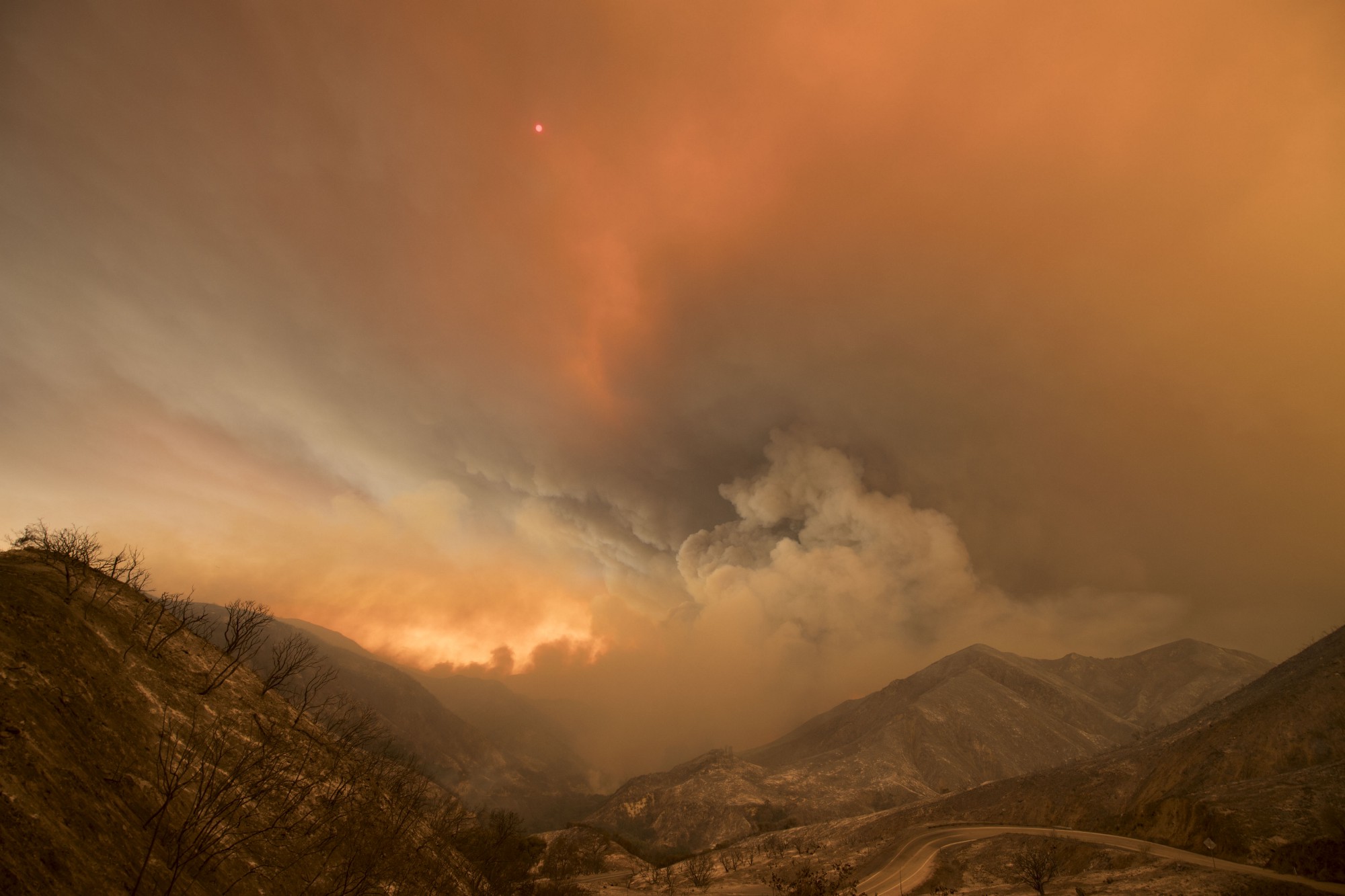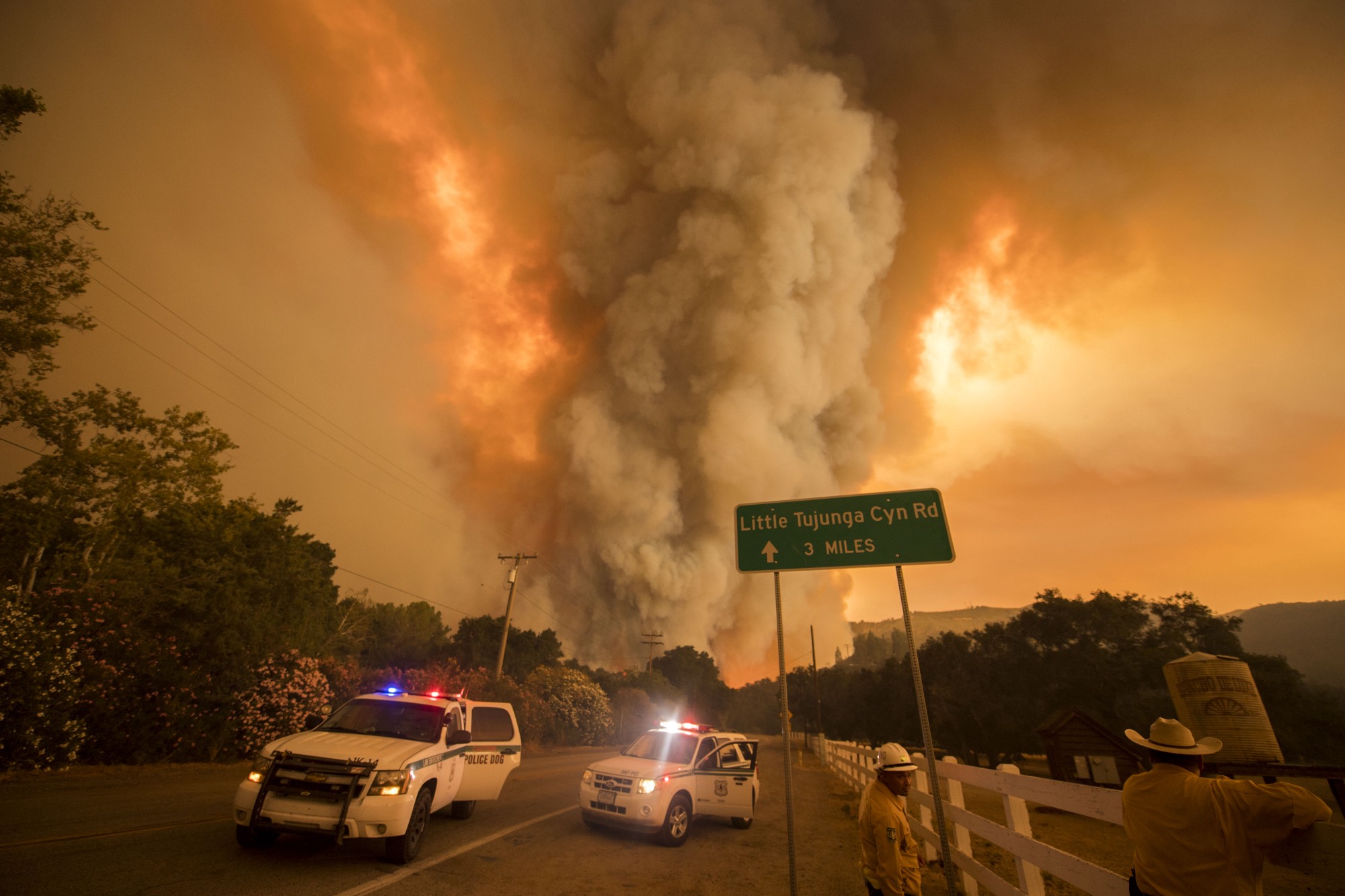Southern California’s latest wildfire is a sign of things to come.
By Eric Holthaus
Firefighters this weekend at the Sand Fire in Southern California. (Photo: Stuart Palley)
Wildfires are a normal part of life in Southern California. But what’s burning right now is not a normal fire.
As of midday Sunday, the Sand Fire had grown to 22,000 acres (34 square miles) — roughly the same size as the island of Manhattan — and was just 10 percent contained. In nearby Los Angeles, the fire prompted frequent references to the Apocalypse this weekend, as the large smoke plume dropped ash and blotted out the sun.
The fire, which started as a small brush fire along the side of Highway 14 near Santa Clarita, California, on Friday, quickly spread out of control under weather conditions that were nearly ideal for explosive growth. The fire doubled in size overnight on Friday, and then doubled again during the day on Saturday.
Simply put: Extreme weather and climate conditions have helped produce this fire’s extreme behavior. Firefighters won’t catch much of a break from the weather all this week.
“The fire behavior was some of the most extreme I’ve seen in the Los Angeles area in my career,” says Stuart Palley, a wildfire photographer based in Southern California. “The fire was running all over the place. … It was incredible to see.” There were multiple reports of flames 50 to 100 feet high on Saturday, which is unusual for fires in the region.
Smoke from the fire, burning through parts of the Angeles National Forest just north of Los Angeles, is visible from the city and cast a pall over the entire region this weekend, prompting sinister scenes. Ash rained down on cars and beaches. The sun appeared as a smoky red ball in the sky in downtown Los Angeles on Saturday, and the fire was a trending topic on Twitter. Smoke from the fire has reached as far as Las Vegas.

(Photo: Stuart Palley)
As of Sunday, more than 1,600 firefighters have been dispatched to the fire, and 18 homes have been destroyed. The National Weather Service has issued a Red Flag warning for wildfire growth, citing the combination of record heat, low humidity, and gusty winds up to 35 miles per hour. About 1,500 homes have been evacuated, and officials warned on Saturday that up to an additional 45,000 homes could be threatened if winds change, which may happen later this week. Firefighters expected to make progress toward containing the fire on Sunday, though air support was partially suspended when a drone was spotted flying in the area. (Drone flights near wildfires have been a recurring problem in recent years.)
In a news briefing on Saturday, L.A. County Fire Chief Daryl Osby blamed the fire’s quick growth in part on the ongoing drought, now in its fifth consecutive year. The area where the fire is burning has been under “exceptional” drought, the highest of four severity levels, since early 2014 — one of the hardest-hit parts of the state. Since late 2011, Los Angeles County has missed out on about three years’ worth of rain. Simply put: Extreme weather and climate conditions have helped produce this fire’s extreme behavior.
We’re now in the heart of Southern California’s annual six-month dry season, but the drought has made this summer’s heat and fire risk worse — wildfire season is essentially year-round now. The last below-normal temperature day in Los Angeles was June 14, and high temperatures near the fire are expected to remain near the 100-degree mark, slightly above normal, until at least Friday. That means firefighters won’t catch much of a break from the weather all this week.
California’s risk of a mega-drought — spanning decades or more — is, or will be soon, the highest it’s been in millennia.
For firefighters, the Sand Fire is the latest in a string of destructive fires so far this year. Last month’s Erskine Fire near Lake Isabella burned about 200 homes and at times was advancing as fast as 50 mph. Even before this year’s dry season, firefighters statewide feared a greater risk of large fires like these.
A survey from the United States Forest Service this spring found 40 million dead trees statewide and estimated that 29 million of those trees had died just in the last year, worsening wildfire risk and creating a temporary year-round autumn-like landscape. Though other human activities, like changes in land use and forest management practices, can also increase wildfire risk, the evidence increasingly points to an upward nudge from climate change too.
Warmer temperatures, from global warming and from incredibly low soil moisture levels, are also likely to prolong the drought itself, according to several recent studies. What’s worse, this past winter’s El Niño weather pattern, which typically brings above-normal volumes of rain to Southern California, failed to do so.

(Photo: Stuart Palley)
Even if rainfall amounts don’t change in the future, drought and wildfire severity likely will because warmer temperatures are more efficient at evaporating what little moisture does fall. That, according to scientists, means California’s risk of a mega-drought — spanning decades or more — is, or will be soon, the highest it’s been in millennia.
Palley, who has trained alongside firefighters, called Sunday a “make-or-break day” for those working to contain the Sand Fire. But more than that, Palley says the fire is a sign of things to come, as climate change boosts the risk of future large fires in the region. “This is probably the most in-your-face reminder that Los Angeles residents have had because of all the smoke that’s being put out into the L.A. Basin,” Palley says. “All bets are off. The fuels are just so, so dry. It’s definitely an ominous feeling.”

||





